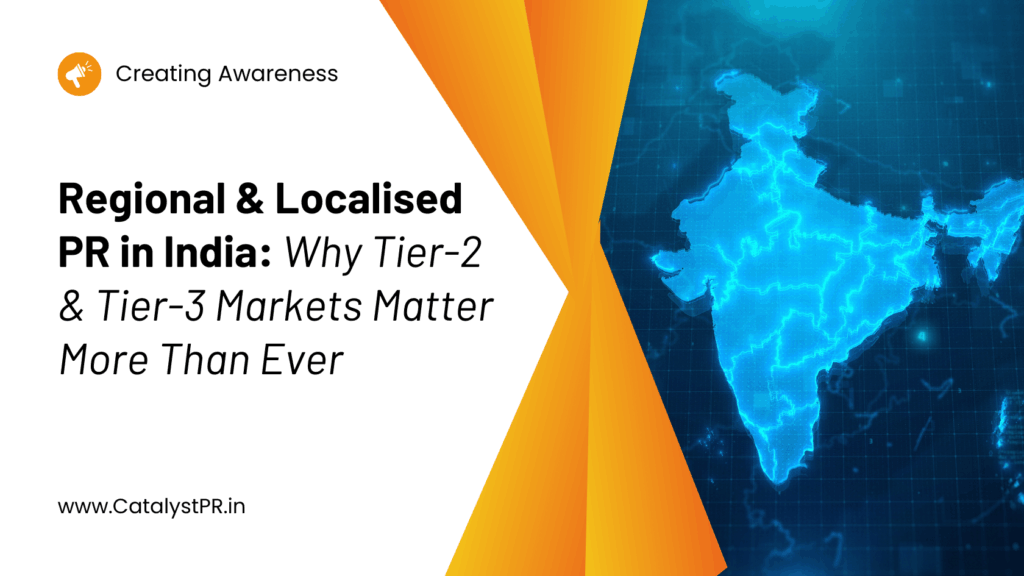For decades, Public Relations in India revolved around the metros — Delhi, Mumbai, Bengaluru, and Chennai. The big campaigns, the high-budget product launches, the celebrity endorsements — they all spoke to the urban elite. But as India’s economic map shifts, so does its media map.
Today, the pulse of opportunity beats strongest not in skyscrapers but in smaller towns. Tier-2 and Tier-3 cities — once seen as secondary markets — have become the new centres of attention for brands, politicians, and policymakers alike. And for PR professionals, this change opens a landscape rich with potential and personality.
1. The New Heartland of Growth
India’s smaller cities are no longer “aspiring” — they are achieving. With improving infrastructure, growing digital access, and higher disposable incomes, these regions are driving consumption like never before.
According to several market studies, Tier-2 and Tier-3 cities account for more than 60% of new internet users in India. E-commerce giants, fintech startups, and healthcare brands are all expanding beyond metros because the next wave of loyal customers lives here.
For PR, this means communication strategies must evolve — because audiences here don’t just consume media differently; they feel it differently.
2. The Power of Vernacular Storytelling
One of the biggest lessons in regional PR is that language builds trust.
English and Hindi may dominate national media, but in smaller towns, regional languages are the emotional connectors. Tamil, Malayalam, Kannada, Marathi, Bengali, Gujarati — each carries its own rhythm, humor, and cultural nuance.
A PR campaign that works in Delhi might completely miss the mark in Madurai or Coimbatore. The secret lies in localisation — not just translating, but transcreating. That means crafting stories that reflect local values, idioms, festivals, and even humour.
At Catalyst PR, we often say: “A story told in the audience’s mother tongue isn’t just heard — it’s believed.”
3. Local Media: The Unsung Hero of Influence
While digital platforms dominate conversations in metros, regional print, FM radio, and local TV still hold immense credibility in smaller markets.
Local editors, reporters, and community leaders act as opinion shapers — and maintaining relationships with them is as critical as securing national coverage.
Regional PR is not about scale alone; it’s about depth. A single feature in a respected regional daily can drive more meaningful brand engagement than multiple national mentions.
4. Building Community Connections, Not Just Coverage
Tier-2 and Tier-3 PR thrives on community belonging.
Unlike metro audiences, smaller-city consumers value authenticity and personal touch. Events, CSR initiatives, and on-ground activations that directly benefit local communities create lasting goodwill.
For example, a healthcare brand sponsoring a free check-up camp in Salem or a fintech company offering financial literacy workshops in Madurai, often generates more organic visibility and brand loyalty than a costly influencer campaign.
5. Digital Media Has Gone Hyperlocal
With the rise of regional YouTubers, local Instagram creators, and state-specific news apps, digital PR in smaller towns is booming.
Hyperlocal influencers now hold real sway — they speak their audience’s dialect, share their lifestyles, and have built genuine trust.
For modern PR strategists, this means combining traditional local media with micro-influencer collaborations to create a 360-degree regional presence.
6. The Future of PR Is Glocal — Global Thinking, Local Storytelling
Brands that thrive tomorrow will be those that balance global aspirations with regional sensitivity. The “one-size-fits-all” communication model no longer works.
Instead, Glocal PR — thinking globally but speaking locally — is becoming the new mantra.
For agencies like Catalyst PR, the mission is clear: amplify voices that truly represent India’s diversity. From Chennai to Coimbatore, from Kochi to Kurnool, the next great brand stories will emerge not from corporate boardrooms but from the heart of regional India.
Conclusion:
Tier-2 and Tier-3 markets are not just the future of consumer growth — they’re the future of authentic communication. The brands that understand local emotion, culture, and conversation will not just reach new audiences — they’ll earn them.


